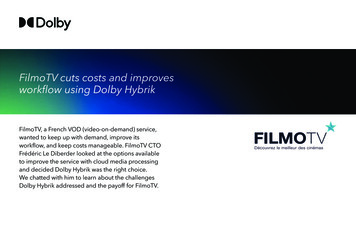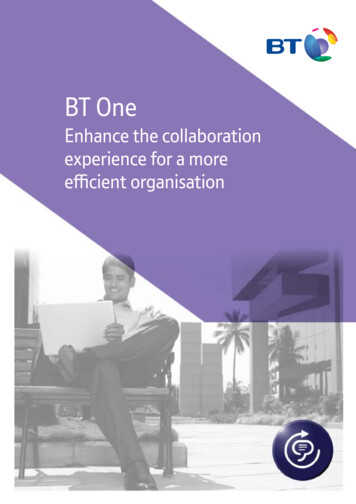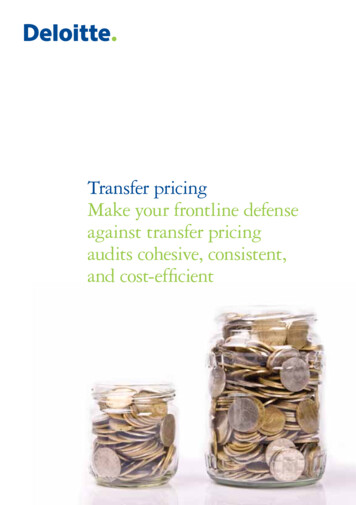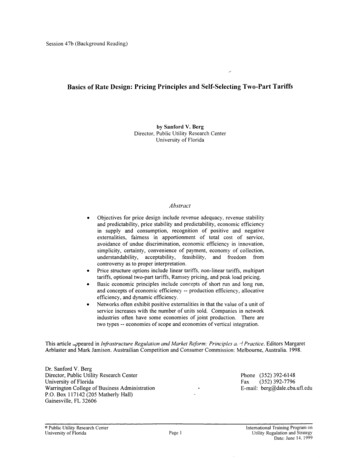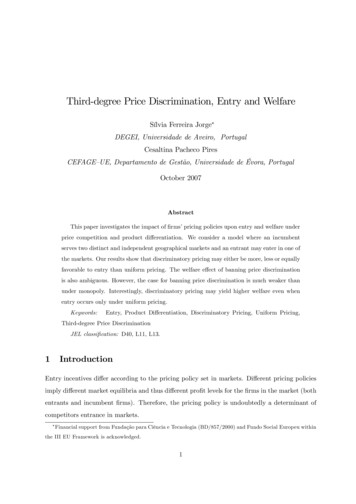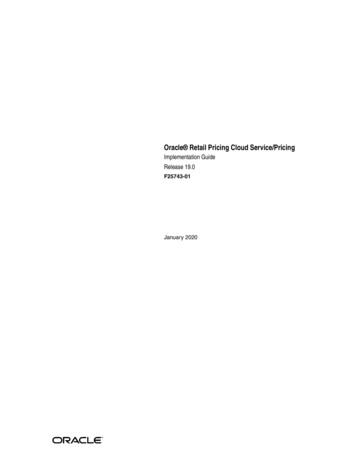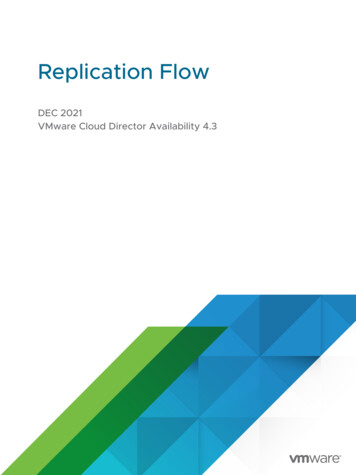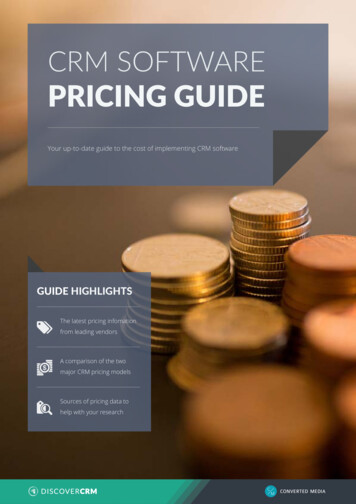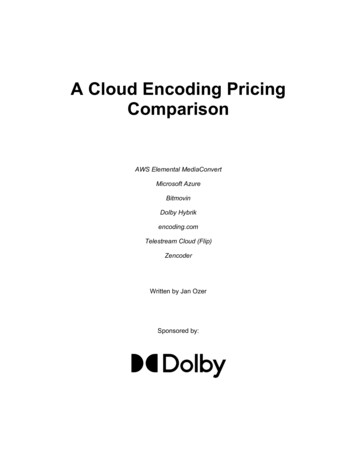
Transcription
A Cloud Encoding PricingComparisonAWS Elemental MediaConvertMicrosoft AzureBitmovinDolby Hybrikencoding.comTelestream Cloud (Flip)ZencoderWritten by Jan OzerSponsored by:
OverviewSelecting a cloud encoding partner is challenging, with well over a dozen vendors providing avariety of services. Directly comparing these services can be surprisingly complex, since theyeach offer a different take on features, performance, quality, and price. Even comparingservices on price is harder than it first looks, since they all use different pricing schemas. Forexample, one vendor might charge by-the-output-minute while another charges by-totalgigabytes.To assist companies considering moving to the cloud or changing vendors, Dolbycommissioned me to write this white paper comparing the H.264 and H.265 pricing of sevenleading vendors, including Dolby’s own Hybrik encoding service. By way of background, Dolby’sservice is optimized for large-scale media processing, and is used by companies like SonyPictures, Viacom-CBS, and WarnerMedia.To compare pricing between the services, I needed to establish a standardized outputconfiguration. Since many media companies serve their viewers with multi-bitrate HTTP LiveStreaming (HLS), I decided to use Apple’s recommended encoding ladders from the HLSAuthoring Specification. This meant one test for the H.264 encoding (going up to 1080presolution) and one test for H.265 (going up to 4K resolution). I used the publicly availablepricing for all services.Cost Comparison SummaryTable 1 shows the summary cost comparison for H.264 encoding, with cost computed as amonthly expense based on the total number of hours of source material processed with pricingdetails provided later in this document. As you can see, pricing for the per-minute or per-GBservices ranges between 8 and 40 to encode a H.264 ladder from a single source hour.The Hybrik service is an outlier at both ends of the hourly range. At very low volumes, theservice is comparatively expensive since the minimum service level is 1000 per month. So,encoding a single hour of source took 1 of machine time, plus the 1,000 base service cost. Asthe number of source hours encoded per month increases however, the Dolby Hybrik servicebecomes the overwhelmingly less-expensive option, dropping to a fraction of the other servicesafter 200 hours or so.Service CostMonthly Source Hours10020030011050AWS MediaConvert 17 170 849 1,698 3,396Azure Media Services 12 122 608 1,215Bitmovin 25 246 1,228 1,001 1,007 17 167Dolby HybrikEncoding.com4001000 5,094 6,792 16,980 2,430 3,645 4,860 12,150 2,456 4,912 7,369 9,825 24,562 1,037 1,074 1,148 1,222 1,296 1,740 833 1,666 3,332 4,999 6,665 16,662Telestream Cloud 8 84 420 840 1,680 2,520 3,360 8,400Zencoder 40 300 1,215 2,000 3,240 4,860 6,480 16,200Table 1. Monthly cost summary per hour of source for H.264 encoding.Figure 1 shows the cost as a chart. The horizontal axis shows the number of monthly sourcehours ranging from 1 to 1000, and the vertical axis shows the monthly encoding cost for thosehours for each encoding platform.
Figure 1. Monthly encoding costs by service and volume – H.264Table 2 shows the summary cost comparison for H.265 encoding of the Apple-recommended4K ladder. The costs here are substantially higher than for the H.264 ladder.Service CostMonthly Source Hours100200300110AWS MediaConvert 252 2,526 25,260 50,520Azure Media Services 121 1,212 12,117 24,234Bitmovin 92 924 9,238 1,009 1,093Encoding.com 56Telestream CloudZencoderDolby Hybrik4001000 75,780 101,040 252,600 36,351 48,468 121,170 18,477 27,715 36,953 92,383 1,926 3,852 4,778 6,704 14,260 553 5,530 11,059 16,589 22,119 55,297 61 606 6,060 12,120 18,180 24,240 60,600 61 459 3,060 6,120 9,180 12,240 30,600Table 2. Monthly cost summary per hour of source for H.265 encoding.Two factors drive this cost increase. First, is that the ladder has three additional rungs (1 at1440p and 2 at 4K). These larger resolutions require substantially more encoding processing –remember that if you double the resolution, you have four times the number of pixels.The second factor is that H.265 (HEVC) is a more complex codec than H.264. H.265 canachieve reductions of up to 50% in bandwidth for the same output quality as H.264, but thesereductions come at the cost of increased processing requirements. H.265 can take anywherebetween 2x and 10x the processing time of an equivalent H.264 encode. Figure 2 shows agraph of the pricing data shown in Table 2.
H.265 Pricing Comparison 250,000.00Monthly Encoding Cost 200,000.00 150,000.00AWS MediaConvertAzure Media ServicesBitmovinDolby HybrikEncoding.com 100,000.00Telestream CloudZencoder 50,000.00 0.0001002003004005006007008009001000Monthly Source HoursFigure 2. Monthly encoding costs by service and volume – H.265As I close this summary section, I will point out that achieving a precise apples-to-applescomparison between the services is difficult. For example, the goal was to compare the cost of2-pass high-quality encoding from each service. However, Telestream’s Cloud Flip service onlyoffers one-pass encoding. How does Telestream’s single-pass output compare to the two-passoutput from other services? That’s beyond the scope of this analysis, but it’s a comparison youshould perform before choosing a cloud vendor.In addition, note that few services expose all configuration options that impact quality, like thecodec preset, which trades off quality for encoding time. So, even if the service uses a highquality codec, like x264, you may not have control over the most relevant quality-relatedconfiguration option. In contrast, Hybrik provides complete control over all options available inx264 and x265, providing you with complete control over the cost/quality equation. Ultimately,price can’t be your only decision point. You will need to assess the quality of your prospectiveservices to see if they meet your overall requirements.Project AssumptionsI ran two different projects with two different assumptions. The H.264 project assumed a onehour 1080p source video at 30fps supplied in MXF format at 50 Mbps encoded to therecommended H.264 encoding ladder in the Apple HLS Authoring Specification. I also encodedtwo audio streams, one at 128 kbps for the 540p resolution rungs and higher, and one at 64kbps for the lowest ladder rungs. I packaged the video in a single ABR format using two-passencoding (if available). For consistency, I priced all services assuming operation in the AmazonAWS US East region.Table 3 shows the H.264 encoding ladder, with nine video layers plus two audio layers. Whenyou’re paying by the minute, each rung is a separate minute, so each source hour generates
540 minutes of output video (60 minutes times nine rungs) plus 120 audio output minutes (60minutes times 2 rungs). Most vendors charge different prices for UHD, Full HD, SD, and audiominutes, so you’ll need to know the minutes of each type to accurately calculate the price.Layer #Layer SizeVideo (Mb/s)Audio (Mb/s)Total (Mb/s)Total 0.880.480.320.160.06Audio 164 kbps0.0000.0640.0640.03Audio 2128 le 3. H.264 encoding ladderAs shown in Table 3, each source video hour generates a total of 11.35 GB of output, which Icomputed because encoding.com charges by the GB of combined input and output. At 50Mbps, our one-hour source video equals 21.97 GB of input, which totals 33.32 GB (source plusoutput) for each hour of video processed.The HEVC test project assumed a one-hour 30 fps 4K video in MXF format at 200 Mbpsencoded to the recommended standard dynamic range HEVC Apple-recommended encodingladder as shown in Table 4. The ladder includes 12 video layers, plus 2 audio layers. As before,each output is a separate minute, so each hour of source video generates 720 minutes of outputvideo (60 minutes times 12 rungs) and 120 output audio minutes (60 minutes times 2 rungs).Layer #Layer SizeVideo (Mb/s)Audio (Mb/s)Total (Mb/s)Total (GB/hr)1234567893840 x 21603840 x 21602560 x 14401920 x 10801920 x 10801280 x 7201280 x 720960 x 540960 x 00.9007.385.103.562.551.981.491.050.700.4010960 x 5400.60000.6000.2611768 x 4320.30000.3000.1312640 x 3600.14500.1450.06Audio 1Audio 264 kbps128 kbpsTotal .340.030.0624.76Table 4. H.265 encoding ladderFor a 200 Mbps source video, the input equals 87.89 GB/hour for a total of 112.65 GB per hourof processed video.
Pricing ModelsThere are four basic pricing models in the cloud encoding market These are:Per-minute pricing – Here the service charges by the minute of output. Most companies in ourcomparison use this pricing model, which works one of two ways (which I’ll explain further foreach service). Some services have a fixed price for each form of output: e.g., SD is 0.02/min;HD is 0.04/min, audio is 0.005/min.Alternately, other services have one standard per-minute price (e.g., 0.02/minute) withmodifiers for the resolution or output codec. For example, an HD minute might have a 2xmultiplier, a UHD minute might have a 4x multiplier, and HEVC output might have a 2xmultiplier. These multipliers combine, so 4K HEVC output would cost 8x SD H.264 output.Per-GB pricing – Here, the service charges by the total GB of input/output minutes. Becausethe source format can have a big impact on the overall cost, it is important to know what yourexpected sources will be. The only service in our comparison using this pricing is encoding.com.Dedicated machine pricing - Some companies allow you to rent a computer in the cloud andprocess as much content as possible during the rental period. This is generally less expensivethan per-GB or per-minute pricing but is very service provider and project specific. Since thecompanies in our comparison don’t publish pricing for this option, I didn’t attempt to computepricing under this model.Dolby Hybrik pricing – Dolby Hybrik uses a Platform-as-a-Service (PaaS) pricing model. TheHybrik service manages the media processing, but the machines processing the video areactually running in your own cloud account on either Amazon AWS or Google GCP. In additionto processing cost, this has the advantage of safeguarding your data in your own Virtual PrivateCloud (VPC) environment.With Hybrik, you don’t actually pay Dolby for the machine time that you use – you pay eitherAWS or GCP directly for that. You pay a flat monthly fee to Dolby based on the total number ofcloud machines that you want to be able to simultaneously run. Hybrik is designed to spin-upmachines on the “spot” market, which is substantially less expensive than using on-demandmachines. The fee to Dolby (with service levels in between) is: 10 cloud machines - 1,000/month100 cloud machines - 5,000/month1000 cloud machines - 10,000/monthAs you’ll see, the Hybrik costs in our comparison includes both the Dolby Hybrik fee and thecost of the machine time paid to the cloud vendor, which was AWS in this case.Note that cloud platforms like AWS and GCP charge for data to be moved outside of the regionwhere it is stored. So, for example, if you were to take data stored in us-east-1 on AWS andprocess it on a service running in eu-west-1, you would incur a data transfer charge. If your datawas stored on one platform, and you wanted to transcode on a service on a different platform,your data transfer charge would be even higher. Our assumption in the pricing comparisons isthat all storage and services are running on the same platform in the same region.The next section gives a summary of the pricing comparisons between the services. To ensureaccuracy, I checked my computations with each service, so overall cost should be very close to
actual. However, prices and pricing schemas change, and cost analysis can be surprisinglycomplex, so I encourage you to do your own research using this whitepaper as a guide to helpyou understand the options available in the market.As you would expect, at large volumes you may be able to negotiate lower pricing with aspecific vendor. Since I was not in a position to negotiate pricing, I used published pricing for allservices. When vendors offered different pricing schemas, I used the schema most comparableto the other services.Detailed Cost AnalysisDolby Hybrik CostsTo calculate Dolby Hybrik costs, I created encoding ladders as specified above and renderedthe audio and video in the Hybrik system using spot pricing. Other than two-pass encoding, I leftall performance-related options like profile and preset at their default configurations (which wasthe medium preset for both H.264 and H.265).As shown in Table 5, the 1080p H264 project took 2.83 hours to compute on c5.4xlargeinstances that cost 0.26/hour on the spot market for a total processing cost of 0.74. The 4KHEVC project took 35.62 hours of machine time on the same instances for a processing cost of 9.26/hour. Remember that machine time is different from elapsed time – if 10 machines areworking on the same file, then 35 hours of machine time would be 3.5 hours of elapsed time.H264 HLS (9 video layers)10MachineTime (hrs.)2.83H265 HLS (12 video layers)1035.62Job Type# MachinesMachineTypec5.4xlargeMachineCost ( /hr) 0.26c5.4xlarge 0.26Total Cost 0.74 9.26Table 5. Machine time to encode the test project on Hybrik.In terms of service level, Hybrik could produce over 1,000 hours of H264 output with only 10cloud instances, which costs 1,000/month. With HEVC I had to jump to the next service level(20 instances for 2,000/month) to complete 200 hours of HEVC, which was sufficient for allother encoding levels. To keep things simple, I computed and presented the H.264 and HEVCcomparisons separately.Now let’s look at charges for the other services.AWS Elemental MediaConvert CostsAVS Elemental MediaConvert is the pay-as-you-go option for accessing the AWS ElementalTechnologies encoding stack. There are two pricing tiers, Basic and Professional, with the latternecessary to access two-pass encoding. H.264 pricing for 30fps 2-pass encoding is 0.021/minute for SD, 0.042/minute for HD, and 0.005/minute for audio, producing a cost perhour for H.264 output of 16.98, compared to Hybrik’s processing-only cost of 0.74 (Table 6).
Monthly Source HoursAWS H.264 Cost1101002003004001000SD cost (5 rungs) 6.30 63 630 1,260 1,890 2,520 6,300HD cost (4 rungs) 10.08 101 1,008 2,016 3,024 4,032 10,080Audio cost (2 rungs) 0.60 6 60 120 180 240 600MediaConvert Total 16.98 170 1,698 3,396 5,094 6,792 16,980Hybrik Total 1,001 1,007 1,074 1,148 1,222 1,296 1,740Table 6. AWS Elemental MediaConvert costs for monthly source hours – H.264.For 30 fps 2-pass HEVC encoding, AWS Elemental MediaConvert charges 0.168/minute forSD, or 8x the cost of H.264, 0.336/minute for SD, and 0.672 for 4K, with audio at 0.005/minute. Table 7 presents the results, showing an HEVC ladder cost of 252.60/hourcompared to Hybrik’s processing-only cost of 9.26.Monthly Source HoursAWS H.265 Cost1SD cost (5 rungs)10 50.40 5041002003004001000 5,040 10,080 15,120 20,160 50,400HD cost (4 rungs) 80.64 806 8,064 16,128 24,192 32,256 80,6404K cost (3 rungs) 120.96 1,210 12,096 24,192 36,288 48,384 120,960Audio cost (2 rungs)MediaConvert Total 0.60 6.00 60 120 180 240 600 252.60 2,526 25,260 50,520 75,780 101,040 252,600 1,009 1,093 1,926 3,852 4,778 6,704 14,260Hybrik TotalTable 7. AWS Elemental MediaConvert costs for monthly source hours – HEVC.Microsoft Azure CostsMicrosoft Azure is an integrated cloud encoding/cloud platform with a standard and premiumencoder, with the former sufficient for our needs. For H.264 encoding, Azure charges a baseprice of 0.015/minute for the standard encoder, with HD priced at 2x and audio at .25x, or 0.00375/minute. This produces a cost per hour for H.264 output of 12.15/hour, compared toHybrik’s processing-only cost of 0.74 (Table 8).Monthly Source HoursCost Rollup1101002003004001000SD mins. (5 rungs @ 1x) 4.50 45HD mins (4 rungs @ 2x) 7.20 72 450 900 1,350 1,800 4,500 720 1,440 2,160 2,880 7,200Audio mins. (2 rungs @ .25x) 0.45 5 45 90 135 180 450Azure Total 12.15 122 1,215 2,430 3,645 4,860 12,150Hybrik Total 1,001 1,007 1,074 1,148 1,222 1,296 1,740Table 8. Microsoft Azure costs for monthly source hours – H.264.For HEVC, Azure offers three tiers, Speed, Balanced, and Quality. I used Quality, which for30fps video, starts at 0.081/minute for SD (5.4x the cost of H.264), 0.161/minute for HD, and 0.321 for 4K with audio at 0.00375/minute or .25x. For the HEVC ladder, Azure costs 121.17/hour compared to Hybrik’s processing-only cost of 9.26 (Table 9).
Monthly Source HoursAzure H.265 Cost1101002003004001000SD mins. (5 rungs @ 1x) 24.30 243 2,430 4,860 7,290 9,720 24,300HD mins. (4 rungs @ 2x) 38.64 386 3,864 7,728 11,592 15,456 38,6404K mins. (3 rungs @ 4x) 57.78 578 5,778 11,556 17,334 23,112 57,780Audio mins. (2 rungs @.25x) 0.45 5 45 90 135 180 450Azure Total 121.17 1,212 12,117 24,234 36,351 48,468 121,170Hybrik Total 1,009 1,093 1,926 3,852 4,778 6,704 14,260Table 9. Microsoft Azure costs for monthly source hours – HEVC.Note that Azure used to charge for Media Reserved Units (MRUs) that were “recommended ifyour workload requires one or more concurrent tasks to be running.” However, during our pricechecking Microsoft advised that MRUs were discontinued and now the “encoding systemautomatically scales up and down based on load.”BitmovinBitmovin offers two modes of pricing: Software-as-a-Service and deployment within a managedor private cloud. I show SaaS costs here, as Bitmovin does not publish their pricing for a privatedeployment. Note that with the private deployment model, you pay your own hardware costs,plus a per-minute fee that depends upon volume and encoding type. Still, if you opt for a privatedeployment, your overall costs should be lower than those shown below.To compute SaaS costs, I divided Bitmovin’s baseline encoding charge ( 5,499 per year) by thenumber of included minutes (225,000), which equals about 0.024/minute, though most largercustomers will likely qualify for lower pricing. Like other services, there are multipliers for HD (2Xminutes) and UHD (4x minutes). There is also a multiplier depending on the codec used and fortwo-pass encoding. The Bitmovin comparison H.264 to Dolby Hybrik is shown in Table 10.Monthly Source HoursBitmovin H.264 Cost1101002003004001000SD mins.(5 rungs @ 1x)3003,00030,00060,00090,000120,000300,000HD mins. (4 rungs @ 500390,000975,000Total video minutes2-pass encoding (.25x)Total video minutes303003,0006,0009,00012,00030,000Total minutesAudio mins. (2 @ 000Per-minute charge 0.024 0.024 0.024 0.024 0.024 0.024 0.024 25 246 2,456 4,912 7,369 9,825 24,562 1,001 1,007 1,074 1,148 1,222 1,296 1,740Bitmovin TotalHybrik TotalTable 10. Bitmovin costs for monthly source hours – H.264Regarding our 4K HEVC scenario, Bitmovin charges a 2x premium for HEVC. This means that a4K HEVC video layer (defined as between 1080 and 2160 vertical resolution) would have a 8Xmultiplier on total minutes charged. Table 11 shows the results for H.265 encoding.
Cost Rollup110100200SD mins.(5 rungs @ 1x)3003,00030,000HD mins. (4 rungs @ 2x)4804,80048,0004K minutes (3 rungs @ 4x)Total video minutesHEVC Premium (@ 2x)2-pass encoding (.25x)Total video minutesAudio mins. (2 @ 00303003,0006,0009,00012,00030,000Total 3,780,000Per-minute charge 0.024 0.024 0.024 0.024 0.024 0.024 0.024Bitmovin Total 92.38 924 9,238 18,477 27,715 36,953 92,383Hybrik Total 1,009 1,093 1,926 6,852 7,778 8,704 14,260Table 11. Bitmovin costs for monthly source hours – HEVCencoding.comencoding.com has three pricing models, Public Cloud (On-Demand), Hybrid Cloud, andReserved Cloud. Public Cloud is the traditional cloud SaaS model where you upload your filesto the cloud and process in an encoding.com service center, with charges based upon GB ofinput/output. With Hybrid Cloud, you run encoding.com’s software on your own private cloud,much like Bitmovin’s service discussed above. With Reserved Cloud, you pay by the month fora reserved cloud instance that you can run 24/7. Encoding.The company doesn’t publish Reserved Cloud or Hybrid Cloud pricing, and the lowest publishedprice for Public Cloud pricing is 0.50/GB. I asked about this and heard “the annual commitmentwill determine the per GB rate. The .50 / GB pricing would be if a customer committed to 250TBs. On average, our large customers commit to plans that are between 1 Petabyte / year - 20Petabytes / year so pricing is significantly lower.” In our HEVC scenario, throughput reachedabout 1.3 Petabytes so certainly pricing at that level would be lower.Table 13 shows encoding.com’s Public Cloud pricing for H.264, including a cost per hour for theH.264 output of 16.66, compared to Hybrik’s processing-only cost of 0.74 (Table 12).Monthly Source Hoursencoding.com H.264 Cost1101002003004001000Input GB21.972202,1974,3956,5928,78921,973Output GB11.351141,1352,2703,4064,54111,352Total ng.com Total 16.66 167 1,666 3,332 4,999 6,665 16,662Hybrik Total 1,001 1,007 1,074 1,148 1,222 1,296 1,740Table 12. encoding.com costs for monthly source hours – H.264With the 4K HEVC file, input GB quadruples to 87.89 GB, which boosts overall pricingconsiderably (Table 15) though it is still less expensive than several other services that chargemultiples for 4K and HEVC encoding. For our HEVC ladder, encoding.com costs 56.32/hourcompared to Hybrik’s processing-only cost of 9.26/hour (Table 13).
Monthly Source Hoursencoding.com H.265 ,15687,891Output GB24.76227.042,2704,5416,8119,08222,704Total 5Encoding.com Total 56.32 553 5,530 11,059 16,589 22,119 55,297Hybrik Total 1,009 1,093 1,926 3,852 4,778 6,704 14,260Input GBTable 13. encoding.com costs for monthly source hours – HEVCTelestream CloudTelestream Cloud charges 0.01/per-minute, with adjustments for resolution, frame rate, andcodec. Additionally, audio is charged at .5x minutes, or 0.005/minute. For H.264, there’s a 2xadjustment for HD video. This produces a cost per hour for the H.264 output of 8.40, comparedto Hybrik’s processing-only cost of 0.74 (Table 14).Monthly Source HoursTelestream H.264 Cost110100200SD mins. (5 rungs)3003,00030,000HD mins. (4 rungs @ 2x)4804,80048,0007807,80060Total video minutesAudio mins. (2 rungs @ .5x)Total 168,000252,000336,000840,000Per-minute charge 0.01 0.01 0.01 0.01 0.01 0.01 0.01Telestream Cloud Total 8.40 84 840 1,680 2,520 3,360 8,400Hybrik Total 1,001 1,007 1,074 1,148 1,222 1,296 1,740Table 14. Telestream costs for monthly source hours – H.264Telestream charges 4x minutes for HEVC and another 4x minutes for 4K video, producing anHEVC cost of 60.60/hour compared to Hybrik’s processing-only cost of 9.26 (Table 15).Monthly Source HoursCost Rollup1101002003004001000SD mins. (5 rungs @ 0HD mins. (4 rungs @ 04K mins (3 rungs @ ,000,000606006,00012,00018,00024,00060,000Total 006,060,000Per-minute charge 0.01 0.01 0.01 0.01 0.01 0.01 0.01Telestream Cloud Total 60.60 606 6,060 12,120 18,180 24,240 60,600Hybrik Total 1,009 1,093 1,926 3,852 4,778 6,704 14,260Total video minutesAudio mins. (2 rungs @ .5x)Table 15. Telestream costs for monthly source hours – HEVC.
ZencoderZencoder prices on a per-minute basis with the tiered pricing based on the number of minutesper month. With no commitment, the cost is 0.05 per minute. With a 2000/month commitment,the cost can be as low as 0.02 per minute.Each minute of SD H.264 output counts as 1 regular minute, with HD video at 2x minutes, UHDat 4x minutes, and audio at .25x minutes. For the H.264 project, this yields the results shown inTable 16.Monthly Source HoursZencoder H.264 Costs1101002003004001000SD mins. (5 rungs)3003,00030,000HD mins. (4 rungs @ 2,000780,000303003,0006,0009,00012,00030,000Total minutesMonthly 00 40 300 2,000 2,000 2,000 2,000 2,000Included ,000 0.040 0.030 0.020 0.020 0.020 0.020 0.020 0 0 0 1,240 2,860 4,480 14,200 40 300 2,000 3,240 4,860 6,480 16,200 1,001 1,007 1,074 1,148 1,222 1,296 1,740Total video minutesAudio mins. (2 rungs @ .25x)Per-minute ChargeOverage chargeZencoder TotalHybrik TotalTable 16. Zencoder costs for monthly source hours – H.264Zencoder doesn’t charge extra for HEVC; according to my contact at Brightcove, “This is oneway we hope we can motivate our customers to migrate to use more modern codectechnologies. This also enables us to generate optimal multi-codec profiles without transcodingcost being a factor that influences it.” You see the HEVC cost rollup for Zencoder in Table 17.
Monthly Source HoursZencoder H265 Costs1101002003004001000SD mins. (5 rungs)3003,00030,00060,00090,000120,000300,000HD mins. (4 rungs @ 2x)4804,80048,00096,000144,000192,000480,0004K (3 rungs at 4x tal video minutesAudio mins. (2 rungs @ .25x)Total minutesMonthlyIncluded 153,000306,000459,000612,0001,530,000 40 300 2,000 2,000 2,000 2,000 00Charge 0.040 0.030 0.020 0.020 0.020 0.020 0.020Overage charge 21.20 159 1,060 4,120 7,180 10,240 28,600Zencoder total 61.20 459 3,060 6,120 9,180 12,240 30,600Hybrik total 1,009 1,093 1,926 3,852 4,778 6,704 14,260Table 17. Zencoder costs for monthly source hours – HEVCAnalysisAt the very least, the foregoing should inform you that there’s great variability in pricing for cloudencoding. That stated, for most high-volume streaming producers, encoding is not yet acommodity, as most companies require features, workflows, and outputs that not all vendorssupport.Still, when multiple vendors check all the required boxes, price and quality become criticaldifferentiators. Remember that you really can’t assess price without considering output quality,so to get to an apples-to-apples pricing comparison, you’ll have to roll up your sleeves andperform test encodes on all services that make your short list.
pricing for all services. Cost Comparison Summary Table 1 shows the summary cost comparison for H.264 encoding, with cost computed as a monthly expense based on the total number of hours of source material processed with pricing details provided later in this document. As you can see, pricing for the per-minute or per-GB
